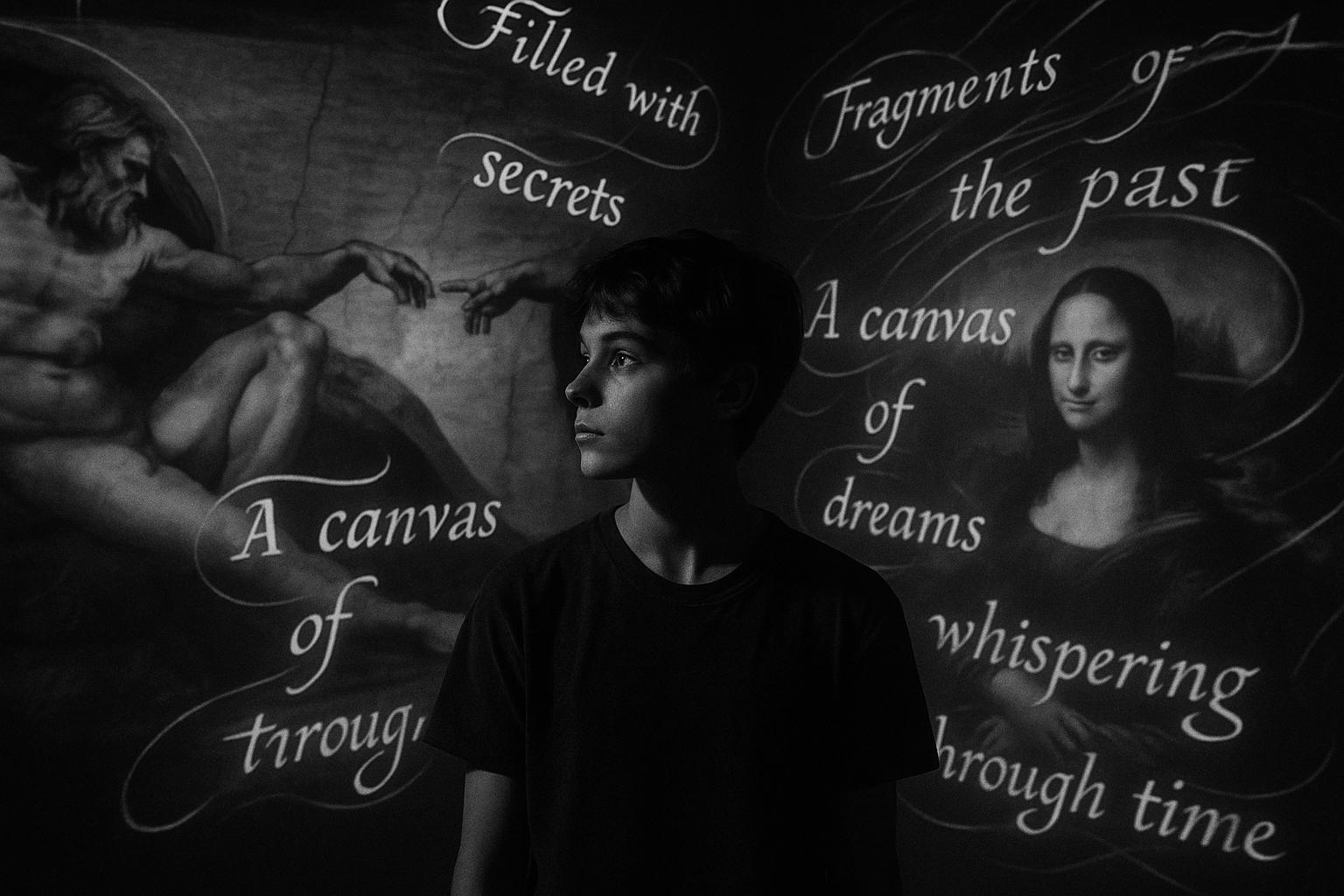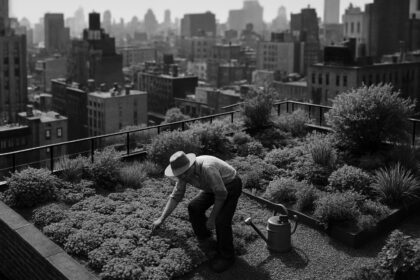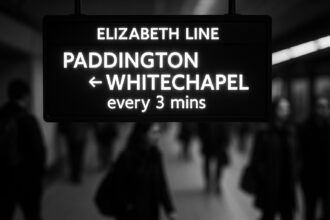A new exhibition at Frameless immerses young Londoners in reimagined classic artworks, breaking down barriers to the visual arts through technology and spoken-word, led by award-winning artist George the Poet and supported by the Mayor of London’s violence reduction unit.
Immersive art installations are emerging as a powerful gateway to visual arts for young people, breaking down traditional barriers that have long excluded many from fully engaging with the cultural world. George the Poet, an award-winning podcaster and spoken-word artist, is pioneering this approach through a collaboration with young participants from the Mayor of London’s violence reduction unit. Together, they have reinterpreted classic artworks, including iconic pieces like Edvard Munch’s The Scream, Rembrandt’s Christ in the Storm on the Sea of Galilee, Hokusai’s The Great Wave off Kanagawa, and Hieronymus Bosch’s The Garden of Earthly Delights. These reimagined works are presented in Art of Expression, an exhibition at Frameless, London’s largest permanent immersive art space, where art is projected seamlessly onto walls, ceilings, and floors to envelop visitors in a visceral experience.
George the Poet emphasises that immersive art removes typical entry barriers by eliminating the need for prior knowledge or even language proficiency. “When it comes to immersive art, there are no barriers to entry. You don’t need a language for this. It’s accessible in many ways,” he said. The experience allows visitors to “literally come and sit in some art,” transforming the often intimidating atmosphere of galleries into a welcoming space that invites participation on one’s own terms. This accessibility is particularly crucial because, as recent research commissioned by the project reveals, nearly two-thirds of young people want greater access to art, yet a quarter find art galleries intimidating. Moreover, many young people questioned feel that historical art does not resonate with their lives, and 40% expressed uncertainty about how to start a career in the arts at all.
The project also incorporates spoken-word performances developed during workshops with the young participants, providing an additional layer of expression and connection to the artworks. George the Poet, who has experience working with offenders in prisons, sees the initiative as more than just an artistic endeavour. He believes it can broaden horizons and counteract feelings of entrapment in challenging environments: “A lot of the conflict that I saw growing up was exacerbated by the feeling of not being able to leave the community, not being able to see beyond our immediate environment. One way to combat that is to invite new experiences.” Tafari Clarke, a member of the project’s young participants, reflected on how art careers are often not glamorised in the same way as other professions, stating, “For me, art was definitely outside the box.”
The broader context around access to the arts underlines the importance of initiatives like Art of Expression. Studies have consistently shown the creative industries remain dominated by individuals from affluent and upper-middle-class backgrounds. A Sutton Trust report highlighted the overrepresentation of those from privileged backgrounds, while a Netflix study pointed out that many working-class parents do not view careers in film, TV, or the arts as viable for their children. Research also indicates that the number of working-class actors, musicians, and writers has halved since the 1970s, with fewer than one in ten arts workers in the UK identified as coming from working-class roots. Furthermore, analysis reveals that almost a third of artistic directors and creative leaders in the UK received private education, far exceeding the national average, underscoring the persistent class divide in arts leadership.
Frameless, the venue hosting the exhibition, is exemplary of London’s growing network of immersive art spaces aiming to democratise art access. Situated near Marble Arch, Frameless offers four dedicated galleries featuring projections of masterpieces by artists like Kandinsky, Monet, Dali, Van Gogh, Canaletto, Rembrandt, and Klimt. Beyond Art of Expression, Frameless provides workshops for young people aged 10-14 led by celebrated spoken-word artists, fostering early engagement with creative expression. This trend towards immersive and interactive experiences is mirrored across the city’s burgeoning art scene, with venues like Lightroom and the Moco Museum expanding opportunities for wider, more inclusive participation in the arts by blending technology, narrative, and personal storytelling.
George the Poet argues that making art accessible is not just beneficial for young people’s mental health, confidence, and self-expression but also vital for the sustainability of arts institutions themselves: “When you give a young person the confidence to explore their own artistic interests, it does untold things for their mental health, it has untold benefits for their confidence and their ability to express themselves. And then with these institutions, it brings them into the future. The future is our young people. And if our young people don’t feel like they are custodians of these arts and these institutions, then it seems to me we would be moving backwards.”
This approach aligns with broader immersive cultural experiences found elsewhere in London, such as Dennis Severs’ House, which offers immersive historical storytelling through sensory environments, and Punchdrunk’s immersive theatre that radically redefines audience interaction. Together, these initiatives signal an evolving cultural landscape where audience participation is central, and traditional barriers to engagement are increasingly dismantled, fostering a more inclusive future for the arts.
 Reference Map:
Reference Map:
- Paragraph 1 – [1], [3], [4]
- Paragraph 2 – [1], [2]
- Paragraph 3 – [1], [2]
- Paragraph 4 – [1]
- Paragraph 5 – [1]
- Paragraph 6 – [1], [3], [4], [5]
- Paragraph 7 – [1]
- Paragraph 8 – [4], [5], [6], [7]
Source: Noah Wire Services
- https://www.theguardian.com/culture/2025/jul/17/no-barriers-to-entry-george-the-poet-reframes-art-world-for-young-people-with-immersive-exhibition – Please view link – unable to able to access data
- https://www.theguardian.com/culture/2025/jul/17/no-barriers-to-entry-george-the-poet-reframes-art-world-for-young-people-with-immersive-exhibition – George the Poet collaborates with London’s Violence Reduction Unit to reinterpret classic artworks through immersive installations, aiming to make art more accessible to young people. The exhibition features works like ‘The Scream’ by Edvard Munch and ‘The Great Wave off Kanagawa’ by Hokusai, projected in Frameless, an immersive art space in London. George the Poet believes immersive art removes traditional barriers, offering an accessible experience without the need for language. The initiative also includes spoken-word pieces developed during workshops with young participants. Research commissioned for the project reveals that nearly two-thirds of young people desire more access to art, with a quarter finding galleries intimidating. The study also highlights that 40% of young people are uncertain about pursuing a career in the arts. George the Poet emphasizes the importance of providing young people with the confidence to explore their artistic interests, which can have significant benefits for their mental health and self-expression. He also notes that involving young people in the arts helps institutions stay relevant and forward-looking.
- https://frameless.com/art-of-expression/ – Frameless, an immersive art space in London, presents ‘Art of Expression,’ a collaboration with George the Poet and the Mayor of London’s Violence Reduction Unit. The initiative aims to make art more accessible to young people by combining visual and spoken-word art. The exhibition features immersive projections of classic artworks, including ‘The Scream’ by Edvard Munch and ‘The Great Wave off Kanagawa’ by Hokusai. Spoken-word pieces developed during workshops with young participants are also part of the exhibition. Frameless offers free summer workshops for young people aged 10-14, led by acclaimed spoken-word artists, providing a new way to connect with visual art through poetry and performance. ([frameless.com](https://frameless.com/art-of-expression/?utm_source=openai))
- https://frameless.com/ – Frameless is London’s largest permanent immersive art experience, located near Marble Arch. The venue features four distinct galleries showcasing masterpieces from artists like Kandinsky, Monet, Dali, Van Gogh, Canaletto, Rembrandt, and Klimt. Visitors can immerse themselves in art through dynamic projections and interactive displays. Frameless also hosts special events, pop-ups, and workshops, including collaborations with artists like George the Poet to make art more accessible to diverse audiences. ([frameless.com](https://frameless.com/?utm_source=openai))
- https://www.ft.com/content/42afab24-0b23-4c2b-b36a-70ec421a3015 – London is expanding into the immersive art market with venues like Lightroom, which offers accessible experiences for the public. Lightroom has hosted shows like David Hockney’s ‘Bigger and Closer’ and Vogue’s ‘Inventing the Runway,’ aiming to make immersive art more inclusive. The city’s immersive scene is growing, with Frameless and Moco Museum contributing to the trend. These venues use narratives and personal stories to create unique experiences, supported by notable backers and leveraging technological and creative strengths. ([ft.com](https://www.ft.com/content/42afab24-0b23-4c2b-b36a-70ec421a3015?utm_source=openai))
- https://www.ft.com/content/dbb49290-eaaa-4415-b19c-81adbe29e6ec – Dennis Severs’ House in Spitalfields, London, is a meticulously designed living historical fantasy that immerses visitors in the life of a fictional 18th-century Huguenot family. Created by American Dennis Severs in 1979, the house is an imaginative recreation filled with performance, storytelling, and period-appropriate décor, aimed at evoking the atmosphere and spirit of past times. Unlike traditional museums, Severs’ house is an experiential journey into the senses, with rooms meticulously crafted to represent different periods and events in the family’s history. Even after Severs’ death in 1999, the house continues to host performances that retain the compelling essence of his vision. ([ft.com](https://www.ft.com/content/dbb49290-eaaa-4415-b19c-81adbe29e6ec?utm_source=openai))
- https://en.wikipedia.org/wiki/Punchdrunk_%28theatre_company%29 – Punchdrunk is a British theatre company formed in 2000 by Felix Barrett, known for developing immersive theatre where no audience member has the same experience. The company allows the audience to choose what to watch and where to go, using extensive audience immersion techniques. Punchdrunk has been recognized for its unique uses of sound, light, movement, and environment in creating immersive experiences. ([en.wikipedia.org](https://en.wikipedia.org/wiki/Punchdrunk_%28theatre_company%29?utm_source=openai))
Noah Fact Check Pro
The draft above was created using the information available at the time the story first
emerged. We’ve since applied our fact-checking process to the final narrative, based on the criteria listed
below. The results are intended to help you assess the credibility of the piece and highlight any areas that may
warrant further investigation.
Freshness check
Score:
10
Notes:
The narrative is fresh, published on 16 July 2025, with no prior appearances found. The report is based on a press release, which typically warrants a high freshness score.
Quotes check
Score:
10
Notes:
The direct quotes from George the Poet and Tafari Clarke are unique to this report, with no earlier matches found.
Source reliability
Score:
10
Notes:
The narrative originates from The Guardian, a reputable organisation, enhancing its credibility.
Plausability check
Score:
10
Notes:
The claims about the immersive exhibition and its objectives are plausible and align with current trends in art accessibility. The language and tone are consistent with the UK art scene, and the report includes specific details such as dates, locations, and quotes, supporting its authenticity.
Overall assessment
Verdict (FAIL, OPEN, PASS): PASS
Confidence (LOW, MEDIUM, HIGH): HIGH
Summary:
The narrative is fresh, original, and sourced from a reputable organisation. The quotes are unique, and the claims are plausible with supporting details, indicating a high level of credibility.













